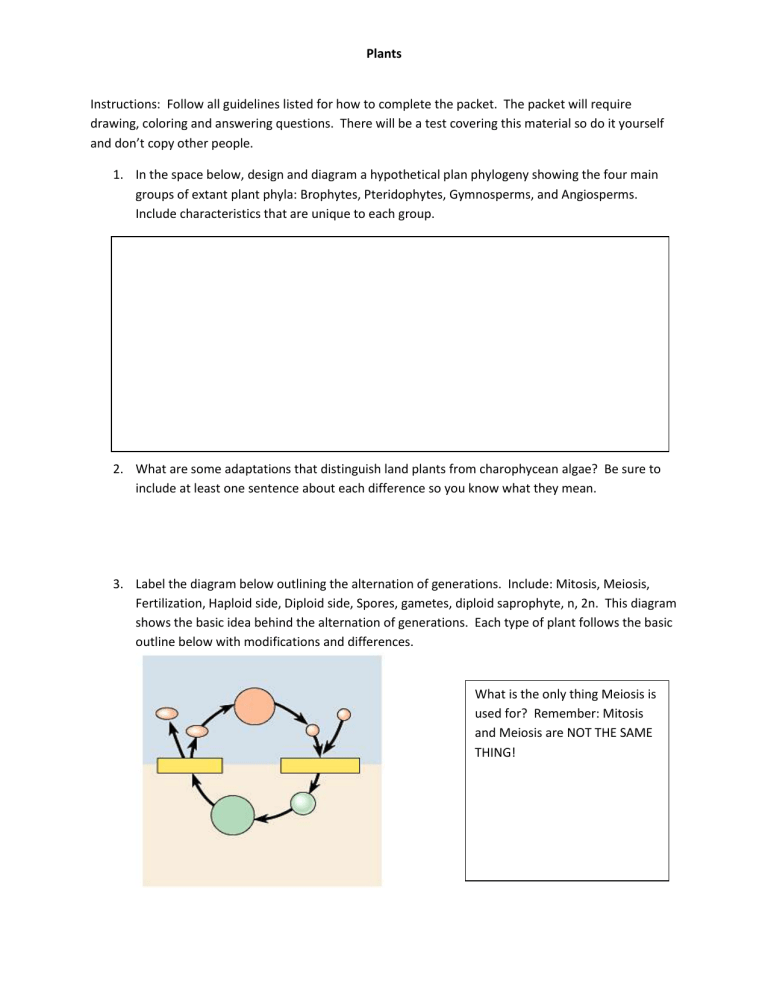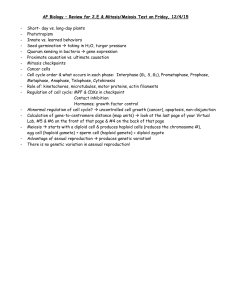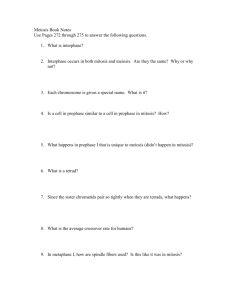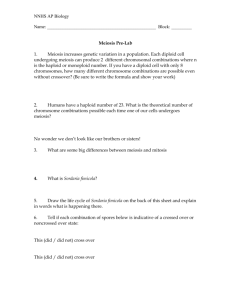Instructions: Follow all guidelines listed for how to complete the packet

Plants
Instructions: Follow all guidelines listed for how to complete the packet. The packet will require drawing, coloring and answering questions. There will be a test covering this material so do it yourself and don’t copy other people.
1.
In the space below, design and diagram a hypothetical plan phylogeny showing the four main groups of extant plant phyla: Brophytes, Pteridophytes, Gymnosperms, and Angiosperms.
Include characteristics that are unique to each group.
2.
What are some adaptations that distinguish land plants from charophycean algae? Be sure to include at least one sentence about each difference so you know what they mean.
3.
Label the diagram below outlining the alternation of generations. Include: Mitosis, Meiosis,
Fertilization, Haploid side, Diploid side, Spores, gametes, diploid saprophyte, n, 2n. This diagram shows the basic idea behind the alternation of generations. Each type of plant follows the basic outline below with modifications and differences.
What is the only thing Meiosis is used for? Remember: Mitosis and Meiosis are NOT THE SAME
THING!
Plants
Plants must move materials without a circulatory system. Water and minerals must be moved from the roots to the leaves. Carbohydrates produced by photosynthesis must be moved to the rest of the plant and to the stems / roots for storage.
4.
Label the diagram below showing how water moves from the roots, up the stem, to the leaves and then out into the surrounding air. Include water potential numbers to show understanding that water moves from higher to lower water potential areas. Label where adhesion and cohesion occur (they play a role in moving water up a tree against gravity.
What is cohesion?
What is adhesion?
Compare root hairs to microvilli in terms of surface area
Plants
5.
Sugar produced in the leaves by photosynthesis must be transported to other parts of the plant.
Label the picture below to show how sucrose manufactured in mesophyll cells can travel. Label the picture that shows how active transport is responsible for moving sucrose into companion cells and sieve-tube members. *Translocation is a word that gets used more than once in this course. Here, translocation means sugar moving from source to sink. Label the second picture which outlines pressure flow in a sieve tube.
How does this pump compare to the ATP Synthase of the light-dependent reaction?
What does “source to sink” even mean?
Plants
6.
Plants must exchange gases in the leaves for photosynthesis. Label the picture below to show the mechanisms and structural components involved in gas exchange.
What is the roll of the guard cell in gas exchange?
7.
Plants require a variety of nutrients in order to grow, develop, function and reproduce. Some plants form symbiotic relationships with other organisms. Label the diagram of the relationships between the soybean plant and the Rhizobium bacteria.
What type of symbiosis is displayed in this relationship?
Plants
8.
Terrestrial plants reproduce using a variety of different mechanisms. We are primarily concerned with the reproduction of the angiosperm (flowering plants.) Label the picture of the flower with all important reproductive components.
What is the significance in the height differences in the stigma and anther on the flowers above?
9.
In the space below, draw a detailed picture outlining the reproductive cycle of angiosperm plants. Include: how the pollen gets to the egg, what happens after fertilization, the development of the seed, the diploid cells, the haploid cells, mitosis, meiosis, and all other necessary labels.
Plants
Plants respond to their environment as all living things do. Plants use several different types of hormones to perform cell communication so that response can occur.
10.
Fill in the chart below that discusses the various plant hormones and their role.
Hormone Major functions in plants. Examples.
Auxin (IAA)
Cytokinins
Gibberellins
Abscisic Acid
Ethylene
Brassinosteroids
Plants
11.
What is an example of a negative feedback mechanism that plants use in response to a shortage of water? How is this negative feedback system similar to that found in humans in regards to blood glucose regulation?
12.
How is fruit ripening an example of positive feedback in plants? What hormone is responsible for the ripening of fruit?
13.
How do plants use apoptosis after flowers have completed their role in reproduction?
Plants
14.
Plants respond to light in a variety of ways. What is a photoperiod? What is photoperiodism in plants? How does photoperiodism control flowering?
In the space below, draw pictures showing how a plant can move in response to light. Make sure you include the cells and what happens to them during the response.
Plants
15.
Plants have a variety of other response that are not due to light. What is the plant response to gravity? What part of cells allows them to distinguish up from down? Draw a series of three pictures that demonstrate what would happen to plant growth if a plant was allowed to grow, rotated clockwise 90 degrees, allowed to grow, then rotated counterclockwise 90 degrees.
16.
A plant response to mechanical stimuli is known as what?
17.
How does a plant respond to various stresses like flooding, salt and heat?
Plants
18.
Plants have defensive systems that protect them from herbivores, bacteria, fungi and viruses. In the space below, draw a diagram that shows how a corn plant can recruit invertebrates to protect it from herbivores.
19.
Discuss the multiple line defense mechanisms that many plants employ. Include information on
Gene-for-Gene Recognition and Systemic Acquired Resistance. How do plants initialize an immune response that will localize an infection by destroying the infected and adjacent cells to protect the rest of the plant?











